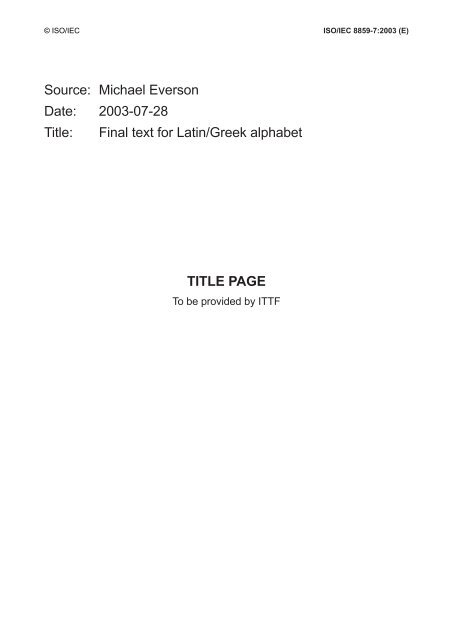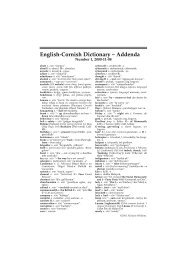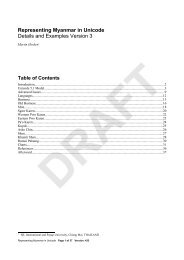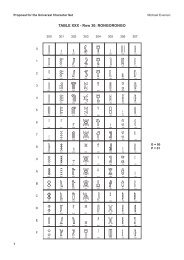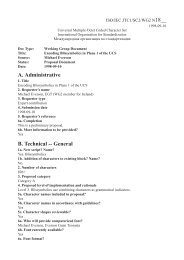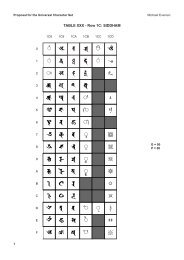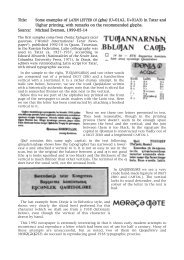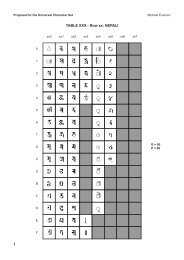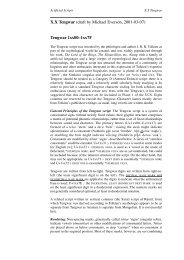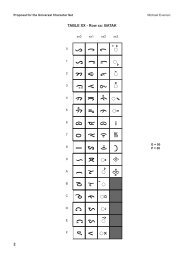Final text for Latin/Greek alphabet TITLE PAGE - Evertype
Final text for Latin/Greek alphabet TITLE PAGE - Evertype
Final text for Latin/Greek alphabet TITLE PAGE - Evertype
You also want an ePaper? Increase the reach of your titles
YUMPU automatically turns print PDFs into web optimized ePapers that Google loves.
© ISO/IEC ISO/IEC 8859-7:2003 (E)<br />
Source: Michael Everson<br />
Date: 2003-07-28<br />
Title: <strong>Final</strong> <strong>text</strong> <strong>for</strong> <strong>Latin</strong>/<strong>Greek</strong> <strong>alphabet</strong><br />
<strong>TITLE</strong> <strong>PAGE</strong><br />
To be provided by ITTF
ISO/IEC 8859-7:2003 (E) © ISO/IEC<br />
Contents<br />
ii<br />
Page<br />
Foreword. . . . . . . . . . . . . . . . . . . . . . . . . . . . . . . . . . . . . . . . . . . iii<br />
Introduction . . . . . . . . . . . . . . . . . . . . . . . . . . . . . . . . . . . . . . . . . iv<br />
1 Scope . . . . . . . . . . . . . . . . . . . . . . . . . . . . . . . . . . . . . . . . . . . . . 1<br />
2 Con<strong>for</strong>mance . . . . . . . . . . . . . . . . . . . . . . . . . . . . . . . . . . . . . . . 1<br />
3 Normative references . . . . . . . . . . . . . . . . . . . . . . . . . . . . . . . . 1<br />
4 Definitions . . . . . . . . . . . . . . . . . . . . . . . . . . . . . . . . . . . . . . . . . 2<br />
5 Notation, code table and names . . . . . . . . . . . . . . . . . . . . . . . 2<br />
6 Specification of the coded character set . . . . . . . . . . . . . . . . 3<br />
7 Identification of the character set . . . . . . . . . . . . . . . . . . . . . . 6<br />
Annex A Coverage of languages by parts 1 to 11 and<br />
13 to 16 of ISO/IEC 8859. . . . . . . . . . . . . . . . . . . . . . . . . 7<br />
Annex B Main differences between ISO 8859-7:1997 and<br />
this first edition of this part of ISO/IEC 8859 . . . . . . . . 9<br />
Annex C Bibliography . . . . . . . . . . . . . . . . . . . . . . . . . . . . . . . . . 10<br />
© ISO/IEC 2003<br />
All rights reserved. Unless otherwise specified, no part of this publication may be<br />
reproduced or utilized in any <strong>for</strong>m or by any means, electronic or mechanical,<br />
including photocopying and microfilm, without permission in writing from the publisher.<br />
ISO/IEC Copyright Office • Case Postale 56 • CH-1211 Genève 20 • Switzerland<br />
Printed in Switzerland
© ISO/IEC ISO/IEC 8859-7:2003 (E)<br />
Foreword<br />
ISO (the International Organization <strong>for</strong> Standardization) and IEC (the<br />
International Electrotechnical Commission) <strong>for</strong>m the specialized system<br />
<strong>for</strong> worldwide standardization. National bodies that are members of ISO or<br />
IEC participate in the development of International Standards through<br />
technical committees established by the respective organization to deal<br />
with particular fields of technical activity. ISO and IEC technical<br />
committees collaborate in fields of mutual interest. Other international<br />
organizations, governmental and nongovernmental, in liaison with ISO<br />
and IEC, also take part in the work.<br />
In the field of in<strong>for</strong>mation technology, ISO and IEC have established a<br />
joint technical committee, ISO/IEC JTC1. Draft International Standards<br />
adopted by the joint technical committee are circulated to the member<br />
bodies <strong>for</strong> voting. Publication as an International Standard requires<br />
approval by at least 75% of the national bodies casting a vote.<br />
International Standard ISO/IEC 8859-7 was prepared by Joint Technical<br />
Committee ISO/IEC JTC1, In<strong>for</strong>mation technology, Subcommittee SC2,<br />
Coded character sets.<br />
This edition cancels and replaces ISO 8859-7:1987 which has been<br />
technically revised.<br />
ISO/IEC 8859 consists of the following parts, under the general title<br />
In<strong>for</strong>mation technology – 8-bit single-byte coded graphic character sets:<br />
– Part 1: <strong>Latin</strong> <strong>alphabet</strong> No. 1<br />
– Part 2: <strong>Latin</strong> <strong>alphabet</strong> No. 2<br />
– Part 3: <strong>Latin</strong> <strong>alphabet</strong> No. 3<br />
– Part 4: <strong>Latin</strong> <strong>alphabet</strong> No. 4<br />
– Part 5: <strong>Latin</strong>/Cyrillic <strong>alphabet</strong><br />
– Part 6: <strong>Latin</strong>/Arabic <strong>alphabet</strong><br />
– Part 7: <strong>Latin</strong>/<strong>Greek</strong> <strong>alphabet</strong><br />
– Part 8: <strong>Latin</strong>/Hebrew <strong>alphabet</strong><br />
– Part 9: <strong>Latin</strong> <strong>alphabet</strong> No. 5<br />
– Part 10: <strong>Latin</strong> <strong>alphabet</strong> No. 6<br />
– Part 11: <strong>Latin</strong>/Thai <strong>alphabet</strong><br />
– Part 12: (unassigned)<br />
– Part 13: <strong>Latin</strong> <strong>alphabet</strong> No. 7<br />
– Part 14: <strong>Latin</strong> <strong>alphabet</strong> No. 8 (Celtic)<br />
– Part 15: <strong>Latin</strong> <strong>alphabet</strong> No. 9<br />
– Part 16: <strong>Latin</strong> <strong>alphabet</strong> No. 10<br />
Annexes A, B, and C of this part of ISO/IEC 8859 are <strong>for</strong> in<strong>for</strong>mation only.<br />
iii
ISO/IEC 8859-7:2003 (E) © ISO/IEC<br />
Introduction<br />
ISO/IEC 8859 consists of several parts. Each part specifies a set of up to<br />
191 graphic characters and the coded representation of these characters<br />
by means of a single 8-bit byte. Each set is intended <strong>for</strong> use <strong>for</strong> a<br />
particular group of languages.<br />
iv
© ISO/IEC ISO/IEC 8859-7:2003 (E)<br />
In<strong>for</strong>mation technology —<br />
8-bit single-byte coded graphic character sets –<br />
Part 7: <strong>Latin</strong>/<strong>Greek</strong> <strong>alphabet</strong><br />
1 Scope<br />
This part of ISO/IEC 8859 specifies a set of 188<br />
coded graphic characters identified as <strong>Latin</strong>/<strong>Greek</strong><br />
<strong>alphabet</strong>.<br />
This set of coded graphic characters is intended <strong>for</strong><br />
use in data and <strong>text</strong> processing applications and<br />
also <strong>for</strong> in<strong>for</strong>mation interchange.<br />
The set contains graphic characters used <strong>for</strong><br />
general purpose applications in typical office<br />
environments in at least the following languages:<br />
English, <strong>Greek</strong>, and <strong>Latin</strong>.<br />
This set of coded graphic characters may be<br />
regarded as a version of an 8-bit code according to<br />
ISO/IEC 2022 or ISO/IEC 4873 at level 1.<br />
This part of ISO/IEC 8859 may not be used in<br />
conjunction with any other parts of ISO/IEC 8859.<br />
If coded characters from more than one part are to<br />
be used together, by means of code extension<br />
techniques, the equivalent coded character sets<br />
from ISO/IEC 10367, or their corresponding G1<br />
sets from the ISO International Register of Coded<br />
Character Sets to be Used with Escape<br />
Sequences, should be used instead within a<br />
version of ISO/IEC 4873 at level 2 or level 3.<br />
The coded characters in this set may be used in<br />
conjunction with coded control functions selected<br />
from ISO/IEC 6429. However, control functions are<br />
not used to create composite graphic symbols from<br />
two or more graphic characters (see clause 6).<br />
NOTE – ISO/IEC 8859 is not intended <strong>for</strong> use with<br />
Telematic services defined by ITU-T. If in<strong>for</strong>mation coded<br />
according to ISO/IEC 8859 is to be transferred to such<br />
services, it will have to con<strong>for</strong>m to the requirements of<br />
those services at the access-point.<br />
2 Con<strong>for</strong>mance<br />
2.1 Con<strong>for</strong>mance of in<strong>for</strong>mation interchange<br />
A coded-character-data-element (CC-dataelement)<br />
within coded in<strong>for</strong>mation <strong>for</strong> interchange<br />
is in con<strong>for</strong>mance with this part of ISO/IEC 8859 if<br />
all the coded representations of graphic characters<br />
within that CC-data-element con<strong>for</strong>m to the<br />
requirements of clause 6.<br />
2.2 Con<strong>for</strong>mance of devices<br />
A device is in con<strong>for</strong>mance with this part of<br />
ISO/IEC 8859 if it con<strong>for</strong>ms to the requirements of<br />
2.2.1, and either or both of 2.2.2 and 2.2.3. A claim<br />
of con<strong>for</strong>mance shall identify the document which<br />
contains the description specified in 2.2.1.<br />
2.2.1 Device description<br />
A device that con<strong>for</strong>ms to this part of ISO/IEC 8859<br />
shall be the subject of a description that identifies<br />
the means by which the user may supply<br />
characters to the device, or may recognize them<br />
when they are made available to him, as specified<br />
respectively in 2.2.2 and 2.2.3.<br />
2.2.2 Originating devices<br />
An originating device shall allow its user to supply<br />
any sequence of characters from those specified in<br />
clause 6, and shall be capable of transmitting their<br />
coded representations within a CC-data-element.<br />
2.2.3 Receiving devices<br />
A receiving device shall be capable of receiving and<br />
interpreting any coded representations of characters<br />
that are within a CC-data-element, and that con<strong>for</strong>m<br />
to clause 6, and shall make the corresponding<br />
characters available to its user in such a way that<br />
the user can identify them from among those<br />
specified there, and can distinguish them from each<br />
other.<br />
3 Normative references<br />
The following standards contain provisions which,<br />
through reference in this <strong>text</strong>, constitute provisions<br />
of this part of ISO/IEC 8859. At the time of publication,<br />
the editions indicated were valid. All standards<br />
are subject to revision, and parties to agreements<br />
based on this part of ISO/IEC 8859 are encouraged<br />
to investigate the possibility of applying the most<br />
recent editions of the standards listed below.<br />
Members of IEC and ISO maintain registers of<br />
currently valid International Standards.<br />
1
ISO/IEC 8859-7:2003 (E) © ISO/IEC<br />
ISO/IEC 2022: 1994, In<strong>for</strong>mation technology –<br />
Character code structure and extension techniques.<br />
ISO/IEC 4873: 1991, In<strong>for</strong>mation technology – ISO<br />
8-bit code <strong>for</strong> in<strong>for</strong>mation interchange – Structure<br />
and rules <strong>for</strong> implementation.<br />
ISO/IEC 8824-1: 1995, In<strong>for</strong>mation technology –<br />
Abstract Syntax Notation One (ASN.1):<br />
Specification of basic notation.<br />
4 Definitions<br />
For the purposes of this part of ISO/IEC 8859 the<br />
following definitions apply:<br />
4.1 bit combination: An ordered set of bits used<br />
<strong>for</strong> the representation of characters. (fr: 4.3)<br />
4.2 byte: A bit string that is operated upon as a<br />
unit. (fr: 4.2)<br />
4.3 character: A member of a set of elements<br />
used <strong>for</strong> the organization, control, or representation<br />
of data. (fr: 4.1)<br />
4.4 code table: A table showing the characters<br />
allocated to each bit combination in a code. (fr: 4.9)<br />
4.5 coded character set; code: A set of<br />
unambiguous rules that establishes a character set<br />
and the one-to-one relationship between the<br />
characters of the set and their bit combinations. (fr:<br />
4.5)<br />
4.6 coded-character-data-element (CC-dataelement):<br />
An element of interchanged in<strong>for</strong>mation<br />
that is specified to consist of a sequence of coded<br />
representations of characters, in accordance with<br />
one or more identified standards <strong>for</strong> coded<br />
character sets. (fr: 4.4)<br />
4.7 graphic character: A character, other than a<br />
control function, that has a visual representation<br />
normally handwritten, printed or displayed, and that<br />
has a coded representation consisting of one or<br />
more bit combinations. (fr: 4.2)<br />
NOTE – In ISO/IEC 8859 a single bit combination is used<br />
to represent each character.<br />
4.8 graphic symbol: A visual representation of a<br />
graphic character or of a control function. (fr: 4.8)<br />
4.9 position: That part of a code table identified<br />
by its column and row coordinates. (fr: 4.7)<br />
5 Notation, code table and names<br />
5.1 Notation<br />
The bits of the bit combinations of the 8-bit code are<br />
identified by b 8, b 7, b 6, b 5, b 4, b 3, b 2, and b 1, where<br />
2<br />
b 8 is the highest-order, or most-significant bit and b 1<br />
is the lowest-order, or least-significant bit.<br />
The bit combinations may be interpreted to represent<br />
numbers in binary notation by attributing the<br />
Bit<br />
Weight<br />
b 8<br />
128 64 32 16 8 4 2 1<br />
following weights to the individual bits:<br />
Using these weights, the bit combinations are<br />
identified by notations of the <strong>for</strong>m xx/yy, where xx<br />
and yy are numbers in the range 00 to 15. The<br />
correspondence between the notations of the <strong>for</strong>m<br />
xx/yy and the bit combinations consisting of the bits<br />
b 8 to b 1 is as follows:<br />
• xx is the number represented by b 8, b 7, b 6 and b 5<br />
where these bits are given the weights 8, 4, 2, and<br />
1 respectively.<br />
• yy is the number represented by b 4, b 3, b 2 and b 1<br />
where these bits are given the weights 8, 4, 2, and<br />
1 respectively.<br />
The bit combinations are also identified by notations<br />
of the <strong>for</strong>m hk, where h and k are numbers in the<br />
range 0 to F in hexadecimal notation. The number<br />
h is the same as the number xx described above,<br />
and the number k is the same as the number yy<br />
described above.<br />
5.2 Layout of the code table<br />
An 8-bit code table consists of 256 positions<br />
arranged in 16 columns and 16 rows. The columns<br />
and the rows are numbered 00 to 15. In hexadecimal<br />
notation the columns and the rows are<br />
numbered 0 to F.<br />
The code table positions are identified by notations<br />
of the <strong>for</strong>m xx/yy, where xx is the column number<br />
and yy is the row number. The column and row<br />
numbers are shown at the top and left edges of the<br />
table respectively. The code table positions are<br />
also identified by notations of the <strong>for</strong>m hk, where h<br />
is the column number and k is the row number in<br />
hexadecimal notation. The column and row<br />
numbers are shown at the bottom and right edges of<br />
the table respectively.<br />
The positions of the code table are in one-to-one<br />
correspondence with the bit combinations of the<br />
code. The notation of a code table position, of the<br />
<strong>for</strong>m xx/yy, or of the <strong>for</strong>m hk, is the same as that of<br />
the corresponding bit combination.<br />
5.3 Names and meanings<br />
b 7 b 6 b 5 b 4 b 3 b 2 b 1
© ISO/IEC ISO/IEC 8859-7:2003 (E)<br />
This part of ISO/IEC 8859 assigns a unique name<br />
and a unique identifier to each graphic character.<br />
These names and identifiers have been taken from<br />
ISO/IEC 10646-1 (E). This part of ISO/IEC 8859<br />
also specifies an acronym <strong>for</strong> each of the<br />
characters SPACE, NO-BREAK SPACE and SOFT<br />
HYPHEN. For acronyms only <strong>Latin</strong> capital letters A<br />
to Z are used. It is intended that the acronyms be<br />
retained in all translations of the <strong>text</strong>.<br />
Except <strong>for</strong> SPACE (SP), NO-BREAK SPACE<br />
(NBSP) and SOFT HYPHEN (SHY), this part of<br />
ISO/IEC 8859 does not define and does not restrict<br />
the meanings of graphic characters.<br />
This part of ISO/IEC 8859 specifies a graphic<br />
symbol <strong>for</strong> each graphic character. This symbol is<br />
shown in the corresponding position of the code<br />
table. However, this part, or any other part, of<br />
ISO/IEC 8859 does not specify a particular style or<br />
font design <strong>for</strong> imaging graphic characters. Annex<br />
B of ISO/IEC 10367 gives further in<strong>for</strong>mation on<br />
this subject.<br />
5.3.1 SPACE (SP)<br />
A graphic character the visual representation of<br />
which consists of the absence of a graphic symbol.<br />
5.3.2 NO-BREAK SPACE (NBSP)<br />
A graphic character the visual representation of<br />
which consists of the absence of a graphic symbol,<br />
<strong>for</strong> use when a line break is to be prevented in the<br />
<strong>text</strong> as presented.<br />
5.3.3 SOFT HYPHEN (SHY)<br />
A graphic character that is imaged by a graphic<br />
symbol identical with, or similar to, that representing<br />
HYPHEN, <strong>for</strong> use when a line break has been<br />
established within a word.<br />
6 Specification of the coded<br />
character set<br />
This part of ISO/IEC 8859 specifies 188 characters<br />
allocated to the bit combinations of the code table<br />
(table 2). None of these characters are combining<br />
characters.<br />
NOTE – Combining characters are described in ISO/IEC<br />
2022:1994 subclause 6.3.3.<br />
Control functions, such as BACKSPACE or<br />
CARRIAGE RETURN, shall not be used to create<br />
composite graphic symbols, which are made up<br />
from the graphic representations of two or more<br />
characters.<br />
6.1 Characters of the set and their coded<br />
representation<br />
See table 1.<br />
Bit<br />
combination<br />
02/00<br />
02/01<br />
02/02<br />
02/03<br />
02/04<br />
02/05<br />
02/06<br />
02/07<br />
02/08<br />
02/09<br />
02/10<br />
02/11<br />
02/12<br />
02/13<br />
02/14<br />
02/15<br />
03/00<br />
03/01<br />
03/02<br />
03/03<br />
03/04<br />
03/05<br />
03/06<br />
03/07<br />
03/08<br />
03/09<br />
03/10<br />
03/11<br />
03/12<br />
03/13<br />
03/14<br />
03/15<br />
04/00<br />
04/01<br />
04/02<br />
04/03<br />
04/04<br />
04/05<br />
04/06<br />
04/07<br />
04/08<br />
04/09<br />
04/10<br />
04/11<br />
04/12<br />
04/13<br />
04/14<br />
04/15<br />
05/00<br />
05/01<br />
05/02<br />
05/03<br />
05/04<br />
05/05<br />
05/06<br />
05/07<br />
05/08<br />
05/09<br />
05/10<br />
05/11<br />
05/12<br />
05/13<br />
05/14<br />
05/15<br />
Table 1 – Character set, coded representation<br />
Hex Identifier<br />
20<br />
21<br />
22<br />
23<br />
24<br />
25<br />
26<br />
27<br />
28<br />
29<br />
2A<br />
2B<br />
2C<br />
2D<br />
2E<br />
2F<br />
30<br />
31<br />
32<br />
33<br />
34<br />
35<br />
36<br />
37<br />
38<br />
39<br />
3A<br />
3B<br />
3C<br />
3D<br />
3E<br />
3F<br />
40<br />
41<br />
42<br />
43<br />
44<br />
45<br />
46<br />
47<br />
48<br />
49<br />
4A<br />
4B<br />
4C<br />
4D<br />
4E<br />
4F<br />
50<br />
51<br />
52<br />
53<br />
54<br />
55<br />
56<br />
57<br />
58<br />
59<br />
5A<br />
5B<br />
5C<br />
5D<br />
5E<br />
5F<br />
U+0020<br />
U+0021<br />
U+0022<br />
U+0023<br />
U+0024<br />
U+0025<br />
U+0026<br />
U+0027<br />
U+0028<br />
U+0029<br />
U+002A<br />
U+002B<br />
U+002C<br />
U+002D<br />
U+002E<br />
U+002F<br />
U+0030<br />
U+0031<br />
U+0032<br />
U+0033<br />
U+0034<br />
U+0035<br />
U+0036<br />
U+0037<br />
U+0038<br />
U+0039<br />
U+003A<br />
U+003B<br />
U+003C<br />
U+003D<br />
U+003E<br />
U+003F<br />
U+0040<br />
U+0041<br />
U+0042<br />
U+0043<br />
U+0044<br />
U+0045<br />
U+0046<br />
U+0047<br />
U+0048<br />
U+0049<br />
U+004A<br />
U+004B<br />
U+004C<br />
U+004D<br />
U+004E<br />
U+004R<br />
U+0050<br />
U+0051<br />
U+0052<br />
U+0053<br />
U+0054<br />
U+0055<br />
U+0056<br />
U+0057<br />
U+0058<br />
U+0059<br />
U+005A<br />
U+005B<br />
U+005C<br />
U+005D<br />
U+005E<br />
U+005F<br />
Name<br />
SPACE<br />
EXCLAMATION MARK<br />
QUOTATION MARK<br />
NUMBER SIGN<br />
DOLLAR SIGN<br />
PERCENT SIGN<br />
AMPERSAND<br />
APOSTROPHE<br />
LEFT PARENTHESIS<br />
RIGHT PARENTHESIS<br />
ASTERISK<br />
PLUS SIGN<br />
COMMA<br />
HYPHEN-MINUS<br />
FULL STOP<br />
SOLIDUS<br />
DIGIT ZERO<br />
DIGIT ONE<br />
DIGIT TWO<br />
DIGIT THREE<br />
DIGIT FOUR<br />
DIGIT FIVE<br />
DIGIT SIX<br />
DIGIT SEVEN<br />
DIGIT EIGHT<br />
DIGIT NINE<br />
COLON<br />
SEMICOLON (used <strong>for</strong> <strong>Greek</strong> erotimatiko)<br />
LESS-THAN SIGN<br />
EQUALS SIGN<br />
GREATER-THAN SIGN<br />
QUESTION MARK<br />
COMMERCIAL AT<br />
LATIN CAPITAL LETTER A<br />
LATIN CAPITAL LETTER B<br />
LATIN CAPITAL LETTER C<br />
LATIN CAPITAL LETTER D<br />
LATIN CAPITAL LETTER E<br />
LATIN CAPITAL LETTER F<br />
LATIN CAPITAL LETTER G<br />
LATIN CAPITAL LETTER H<br />
LATIN CAPITAL LETTER I<br />
LATIN CAPITAL LETTER J<br />
LATIN CAPITAL LETTER K<br />
LATIN CAPITAL LETTER L<br />
LATIN CAPITAL LETTER M<br />
LATIN CAPITAL LETTER N<br />
LATIN CAPITAL LETTER O<br />
LATIN CAPITAL LETTER P<br />
LATIN CAPITAL LETTER Q<br />
LATIN CAPITAL LETTER R<br />
LATIN CAPITAL LETTER S<br />
LATIN CAPITAL LETTER T<br />
LATIN CAPITAL LETTER U<br />
LATIN CAPITAL LETTER V<br />
LATIN CAPITAL LETTER W<br />
LATIN CAPITAL LETTER X<br />
LATIN CAPITAL LETTER Y<br />
LATIN CAPITAL LETTER Z<br />
LEFT SQUARE BRACKET<br />
REVERSE SOLIDUS<br />
RIGHT SQUARE BRACKET<br />
CIRCUMFLEX ACCENT<br />
LOW LINE<br />
3
Bit<br />
combination<br />
06/00<br />
06/01<br />
06/02<br />
06/03<br />
06/04<br />
06/05<br />
06/06<br />
06/07<br />
06/08<br />
06/09<br />
06/10<br />
06/11<br />
06/12<br />
06/13<br />
06/14<br />
06/15<br />
07/00<br />
07/01<br />
07/02<br />
07/03<br />
07/04<br />
07/05<br />
07/06<br />
07/07<br />
07/08<br />
07/09<br />
07/10<br />
07/11<br />
07/12<br />
07/13<br />
07/14<br />
10/00<br />
10/01<br />
10/02<br />
10/03<br />
10/04<br />
10/05<br />
10/06<br />
10/07<br />
10/08<br />
10/09<br />
10/10<br />
10/11<br />
10/12<br />
10/13<br />
10/14<br />
10/15<br />
11/00<br />
11/01<br />
11/02<br />
11/03<br />
11/04<br />
11/05<br />
11/06<br />
11/07<br />
11/08<br />
11/09<br />
11/10<br />
11/11<br />
11/12<br />
11/13<br />
11/14<br />
11/15<br />
ISO/IEC 8859-7:2003 (E) © ISO/IEC<br />
4<br />
Hex<br />
60<br />
61<br />
62<br />
63<br />
64<br />
65<br />
66<br />
67<br />
68<br />
69<br />
6A<br />
6B<br />
6C<br />
6D<br />
6E<br />
6F<br />
70<br />
71<br />
72<br />
73<br />
74<br />
75<br />
76<br />
77<br />
78<br />
79<br />
7A<br />
7B<br />
7C<br />
7D<br />
7E<br />
A0<br />
A1<br />
A2<br />
A3<br />
A4<br />
A5<br />
A6<br />
A7<br />
A8<br />
A9<br />
AA<br />
AB<br />
AC<br />
AD<br />
AE<br />
AF<br />
B0<br />
B1<br />
B2<br />
B3<br />
B4<br />
B5<br />
B6<br />
B7<br />
B8<br />
B9<br />
BA<br />
BB<br />
BC<br />
BD<br />
BE<br />
BF<br />
Identifier<br />
U+0060<br />
U+0061<br />
U+0062<br />
U+0063<br />
U+0064<br />
U+0065<br />
U+0066<br />
U+0067<br />
U+0068<br />
U+0069<br />
U+006A<br />
U+006B<br />
U+006C<br />
U+006D<br />
U+006E<br />
U+006F<br />
U+0070<br />
U+0071<br />
U+0072<br />
U+0073<br />
U+0074<br />
U+0075<br />
U+0076<br />
U+0077<br />
U+0078<br />
U+0079<br />
U+007A<br />
U+007B<br />
U+007C<br />
U+007D<br />
U+007E<br />
U+00A0<br />
U+2018<br />
U+2019<br />
U+00A3<br />
U+20AC<br />
U+20AF<br />
U+00A6<br />
U+00A7<br />
U+00A8<br />
U+00A9<br />
U+037A<br />
U+00AB<br />
U+00AC<br />
U+00AD<br />
U+2015<br />
U+00B0<br />
U+00B1<br />
U+00B2<br />
U+00B3<br />
U+0384<br />
U+0385<br />
U+0386<br />
U+00B7<br />
U+0388<br />
U+0389<br />
U+038A<br />
U+00BB<br />
U+038C<br />
U+00BD<br />
U+038E<br />
U+038F<br />
Table 1 (continued) Table 1 (concluded)<br />
Name<br />
GRAVE ACCENT<br />
LATIN SMALL LETTER A<br />
LATIN SMALL LETTER B<br />
LATIN SMALL LETTER C<br />
LATIN SMALL LETTER D<br />
LATIN SMALL LETTER E<br />
LATIN SMALL LETTER F<br />
LATIN SMALL LETTER G<br />
LATIN SMALL LETTER H<br />
LATIN SMALL LETTER I<br />
LATIN SMALL LETTER J<br />
LATIN SMALL LETTER K<br />
LATIN SMALL LETTER L<br />
LATIN SMALL LETTER M<br />
LATIN SMALL LETTER N<br />
LATIN SMALL LETTER O<br />
LATIN SMALL LETTER P<br />
LATIN SMALL LETTER Q<br />
LATIN SMALL LETTER R<br />
LATIN SMALL LETTER S<br />
LATIN SMALL LETTER T<br />
LATIN SMALL LETTER U<br />
LATIN SMALL LETTER V<br />
LATIN SMALL LETTER W<br />
LATIN SMALL LETTER X<br />
LATIN SMALL LETTER Y<br />
LATIN SMALL LETTER Z<br />
LEFT CURLY BRACKET<br />
VERTICAL LINE<br />
RIGHT CURLY BRACKET<br />
TILDE<br />
NO-BREAK SPACE<br />
LEFT SINGLE QUOTATION MARK<br />
RIGHT SINGLE QUOTATION MARK<br />
POUND SIGN<br />
EURO SIGN<br />
DRACHMA SIGN<br />
BROKEN BAR<br />
SECTION SIGN<br />
DIAERESIS (<strong>Greek</strong> dialytika)<br />
COPYRIGHT SIGN<br />
GREEK YPOGEGRAMMENI<br />
LEFT-POINTING DOUBLE ANGLE QUOTATION MARK<br />
NOT SIGN<br />
SOFT HYPHEN<br />
(This position shall not be used)<br />
HORIZONTAL BAR (<strong>Greek</strong> parenthetiki pavla)<br />
DEGREE SIGN<br />
PLUS-MINUS SIGN<br />
SUPERSCRIPT TWO<br />
SUPERSCRIPT THREE<br />
GREEK TONOS<br />
GREEK DIALYTIKA TONOS<br />
GREEK CAPITAL LETTER ALPHA WITH TONOS<br />
MIDDLE DOT<br />
GREEK CAPITAL LETTER EPSILON WITH TONOS<br />
GREEK CAPITAL LETTER ETA WITH TONOS<br />
GREEK CAPITAL LETTER IOTA WITH TONOS<br />
RIGHT-POINTING DOUBLE ANGLE QUOTATION MARK<br />
GREEK CAPITAL LETTER OMICRON WITH TONOS<br />
VULGAR FRACTION ONE HALF<br />
GREEK CAPITAL LETTER UPSILON WITH TONOS<br />
GREEK CAPITAL LETTER OMEGA WITH TONOS<br />
Bit<br />
combination<br />
12/00<br />
12/01<br />
12/02<br />
12/03<br />
12/04<br />
12/05<br />
12/06<br />
12/07<br />
12/08<br />
12/09<br />
12/10<br />
12/11<br />
12/12<br />
12/13<br />
12/14<br />
12/15<br />
13/00<br />
13/01<br />
13/02<br />
13/03<br />
13/04<br />
13/05<br />
13/06<br />
13/07<br />
13/08<br />
13/09<br />
13/10<br />
13/11<br />
13/12<br />
13/13<br />
13/14<br />
13/15<br />
14/00<br />
14/01<br />
14/02<br />
14/03<br />
14/04<br />
14/05<br />
14/06<br />
14/07<br />
14/08<br />
14/09<br />
14/10<br />
14/11<br />
14/12<br />
14/13<br />
14/14<br />
14/15<br />
15/00<br />
15/01<br />
15/02<br />
15/03<br />
15/04<br />
15/05<br />
15/06<br />
15/07<br />
15/08<br />
15/09<br />
15/10<br />
15/11<br />
15/12<br />
15/13<br />
15/14<br />
15/15<br />
Hex<br />
C0<br />
C1<br />
C2<br />
C3<br />
C4<br />
C5<br />
C6<br />
C7<br />
C8<br />
C9<br />
CA<br />
CB<br />
CC<br />
CD<br />
CE<br />
CF<br />
D0<br />
D1<br />
D2<br />
D3<br />
D4<br />
D5<br />
D6<br />
D7<br />
D8<br />
D9<br />
DA<br />
DB<br />
DC<br />
DD<br />
DE<br />
DF<br />
E0<br />
E1<br />
E2<br />
E3<br />
E4<br />
E5<br />
E6<br />
E7<br />
E8<br />
E9<br />
EA<br />
EB<br />
EC<br />
ED<br />
EE<br />
EF<br />
F0<br />
F1<br />
F2<br />
F3<br />
F4<br />
F5<br />
F6<br />
F7<br />
F8<br />
F9<br />
FA<br />
FB<br />
FC<br />
FD<br />
FE<br />
FF<br />
Identifier<br />
U+0390<br />
U+0391<br />
U+0392<br />
U+0393<br />
U+0394<br />
U+0395<br />
U+0396<br />
U+0397<br />
U+0398<br />
U+0399<br />
U+039A<br />
U+039B<br />
U+039C<br />
U+039D<br />
U+039E<br />
U+039F<br />
U+03A0<br />
U+03A1<br />
U+03A3<br />
U+03A4<br />
U+03A5<br />
U+03A6<br />
U+03A7<br />
U+03A8<br />
U+03A9<br />
U+03AA<br />
U+03AB<br />
U+03AC<br />
U+03AD<br />
U+03AE<br />
U+03AF<br />
U+03B0<br />
U+03B1<br />
U+03B2<br />
U+03B3<br />
U+03B4<br />
U+03B5<br />
U+03B6<br />
U+03B7<br />
U+03B8<br />
U+03B9<br />
U+03BA<br />
U+03BB<br />
U+03BC<br />
U+03BD<br />
U+03BE<br />
U+03BF<br />
U+03C0<br />
U+03C1<br />
U+03C2<br />
U+03C3<br />
U+03C4<br />
U+03C5<br />
U+03C6<br />
U+03C7<br />
U+03C8<br />
U+03C9<br />
U+03CA<br />
U+03CB<br />
U+03CC<br />
U+03CD<br />
U+03CE<br />
Name<br />
GREEK SMALL LETTER IOTA WITH DIALYTIKA AND TONOS<br />
GREEK CAPITAL LETTER ALPHA<br />
GREEK CAPITAL LETTER BETA<br />
GREEK CAPITAL LETTER GAMMA<br />
GREEK CAPITAL LETTER DELTA<br />
GREEK CAPITAL LETTER EPSILON<br />
GREEK CAPITAL LETTER ZETA<br />
GREEK CAPITAL LETTER ETA<br />
GREEK CAPITAL LETTER THETA<br />
GREEK CAPITAL LETTER IOTA<br />
GREEK CAPITAL LETTER KAPPA<br />
GREEK CAPITAL LETTER LAMDA<br />
GREEK CAPITAL LETTER MU<br />
GREEK CAPITAL LETTER NU<br />
GREEK CAPITAL LETTER XI<br />
GREEK CAPITAL LETTER OMICRON<br />
GREEK CAPITAL LETTER PI<br />
GREEK CAPITAL LETTER RHO<br />
(This position shall not be used)<br />
GREEK CAPITAL LETTER SIGMA<br />
GREEK CAPITAL LETTER TAU<br />
GREEK CAPITAL LETTER UPSILON<br />
GREEK CAPITAL LETTER PHI<br />
GREEK CAPITAL LETTER CHI<br />
GREEK CAPITAL LETTER PSI<br />
GREEK CAPITAL LETTER OMEGA<br />
GREEK CAPITAL LETTER IOTA WITH DIALYTIKA<br />
GREEK CAPITAL LETTER UPSILON WITH DIALYTIKA<br />
GREEK SMALL LETTER ALPHA WITH TONOS<br />
GREEK SMALL LETTER EPSILON WITH TONOS<br />
GREEK SMALL LETTER ETA WITH TONOS<br />
GREEK SMALL LETTER IOTA WITH TONOS<br />
GREEK SMALL LETTER UPSILON WITH DIALYTIKA AND TONOS<br />
GREEK SMALL LETTER ALPHA<br />
GREEK SMALL LETTER BETA<br />
GREEK SMALL LETTER GAMMA<br />
GREEK SMALL LETTER DELTA<br />
GREEK SMALL LETTER EPSILON<br />
GREEK SMALL LETTER ZETA<br />
GREEK SMALL LETTER ETA<br />
GREEK SMALL LETTER THETA<br />
GREEK SMALL LETTER IOTA<br />
GREEK SMALL LETTER KAPPA<br />
GREEK SMALL LETTER LAMDA<br />
GREEK SMALL LETTER MU<br />
GREEK SMALL LETTER NU<br />
GREEK SMALL LETTER XI<br />
GREEK SMALL LETTER OMICRON<br />
GREEK SMALL LETTER PI<br />
GREEK SMALL LETTER RHO<br />
GREEK SMALL LETTER FINAL SIGMA<br />
GREEK SMALL LETTER SIGMA<br />
GREEK SMALL LETTER TAU<br />
GREEK SMALL LETTER UPSILON<br />
GREEK SMALL LETTER PHI<br />
GREEK SMALL LETTER CHI<br />
GREEK SMALL LETTER PSI<br />
GREEK SMALL LETTER OMEGA<br />
GREEK SMALL LETTER IOTA WITH DIALYTIKA<br />
GREEK SMALL LETTER UPSILON WITH DIALYTIKA<br />
GREEK SMALL LETTER OMICRON WITH TONOS<br />
GREEK SMALL LETTER UPSILON WITH TONOS<br />
GREEK SMALL LETTER OMEGA WITH TONOS<br />
(This position shall not be used)
© ISO/IEC ISO/IEC 8859-7:2003 (E)<br />
6.2 Code table<br />
For each character in the set the code table (table 2)<br />
shows a graphic symbol at the position in the code<br />
table corresponding to the bit combination specified<br />
in table 1.<br />
The shaded positions in the code table correspond to<br />
bit combinations that do not represent graphic<br />
b 4 b 3 b 2 b 1<br />
0<br />
0<br />
0 0<br />
0 0<br />
0 0<br />
0 1<br />
0 1<br />
0 1<br />
0 1<br />
1 0<br />
1 0<br />
1 0<br />
1 0<br />
1 1<br />
1 1<br />
1 1<br />
1 1<br />
0 0<br />
0 1<br />
1 0<br />
1 1<br />
0 0<br />
0 1<br />
1 0<br />
1 1<br />
0 0<br />
0 1<br />
1 0<br />
1 1<br />
0 0<br />
0 1<br />
1 0<br />
1 1<br />
b 8<br />
b 7<br />
b 6<br />
b 5<br />
00<br />
01<br />
02<br />
03<br />
04<br />
05<br />
06<br />
07<br />
08<br />
09<br />
10<br />
11<br />
12<br />
13<br />
14<br />
15<br />
0<br />
0<br />
0<br />
0<br />
00<br />
0<br />
0<br />
0<br />
0<br />
1<br />
01<br />
1<br />
0<br />
0<br />
Table 2 – Code table of <strong>Latin</strong>/<strong>Greek</strong> <strong>alphabet</strong><br />
1<br />
0<br />
02<br />
0<br />
0<br />
1<br />
1<br />
03<br />
0<br />
1<br />
0<br />
0<br />
04<br />
0<br />
1<br />
0<br />
1<br />
05<br />
0<br />
1<br />
1<br />
0<br />
06<br />
characters. Their use is outside the scope of ISO/IEC<br />
8859; it is specified in other International Standards,<br />
<strong>for</strong> example ISO/IEC 6429.<br />
The positions in the code table that are shown with<br />
cross-hatching correspond to bit combinations in<br />
table 1 having the entry “(This position shall not be<br />
used)”.<br />
0<br />
1<br />
1<br />
1<br />
07<br />
1<br />
0<br />
0<br />
0<br />
08<br />
SP 0 @ P ` p NBSP Æ ˝ ˛ apple<br />
! 1 A Q a q ‘ ± ∞ ƒ · Ú<br />
" 2 B R b r ’ Ç µ ‚ ˜<br />
# 3 C S c s í Ñ ° Á Û<br />
$ 4 D T d t ~ ã ¢ ∆ ‰ Ù<br />
% 5 E U e u ρ á ∂ À Â ˘<br />
& 6 F V f v õ Õ ∑ º ˙ Ê<br />
' 7 G W g w ¨ Ø ∏ Ã Ë ¯<br />
( 8 H X h x å Œ £ æ ı „<br />
) 9 I Y i y © ◊ π ø È ˆ<br />
* : J Z j z È ÿ ∫ ´ Î ˚<br />
+ ; K [ k { « » § Ω Ï ¸<br />
, < L \ l | ¬ Ÿ ª ¿ Ì fi<br />
- = M ] m } SHY ó ¡ ¤ Ó ‡<br />
. > N ^ n ~ ⁄ • ‹ Í Ò<br />
1<br />
0<br />
0<br />
1<br />
09<br />
1<br />
0<br />
1<br />
0<br />
10<br />
1<br />
0<br />
1<br />
1<br />
11<br />
1<br />
1<br />
0<br />
0<br />
12<br />
1<br />
1<br />
0<br />
1<br />
13<br />
/ ? O _ o – fl √ › Ô<br />
2<br />
3<br />
4<br />
5<br />
6<br />
7<br />
8<br />
9<br />
A<br />
B<br />
C<br />
D<br />
1<br />
1<br />
1<br />
0<br />
14<br />
E<br />
1<br />
1<br />
1<br />
1<br />
15<br />
F<br />
0<br />
1<br />
2<br />
3<br />
4<br />
5<br />
6<br />
7<br />
8<br />
9<br />
A<br />
B<br />
C<br />
D<br />
E<br />
F<br />
hex<br />
5
ISO/IEC 8859-7:2003 (E) © ISO/IEC<br />
7 Identification of the character set<br />
7.1 Identification according to ISO/IEC 2022<br />
and ISO/IEC 4873<br />
The graphic characters of this part of ISO/IEC 8859<br />
constitute a single coded character set. However in<br />
accordance with ISO/IEC 2022 and ISO/IEC 4873<br />
the code table of this part of ISO/IEC 8859 may be<br />
considered to consist of the following components:<br />
• The character SPACE represented by bit<br />
combination 02/00;<br />
• a 94-character G0 graphic character set<br />
represented by bit combinations 02/01 to 07/14;<br />
• a 96-character G1 graphic character set<br />
represented by bit combinations 10/00 to 15/15.<br />
When the identification methods of ISO/IEC 2022 or<br />
ISO/IEC 4873 are used this part of ISO/IEC 8859<br />
shall be identified by the following pair of<br />
designation functions:<br />
6<br />
GZD4 04/02 (ESC 02/08 04/02)<br />
G1D6 06/09 (ESC 02/13 06/09)<br />
NOTE 1 – The corresponding escape sequences are<br />
shown in parentheses.<br />
NOTE 2 – The first version of this standard (ISO 8859-<br />
7:1987) was identified as follows:<br />
GZD4 04/02 (ESC 02/08 04/02)<br />
G1D6 04/08 (ESC 02/13 04/06)<br />
7.2 Identification according to ISO/IEC 8824-1<br />
(ASN.1)<br />
In the terminology of ISO/IEC 8824-1 the character<br />
set of this part of ISO/IEC 8859 and the<br />
corresponding coded representations are distinct,<br />
and are known as the “character abstract syntax”<br />
and the “character transfer syntax” respectively.<br />
When the identification methods of ISO/IEC 8824-1<br />
are used this part of ISO/IEC 8859 shall be<br />
identified by the following object identifiers:<br />
• character set<br />
{ iso standard 8859 7 abstract-syntax (1) }<br />
• coded representations<br />
{ iso standard 8859 7 transfer-syntax (0) }<br />
The corresponding object descriptions shall be:<br />
• character set “ISO 8859 part 7 repertoire”<br />
• coded representations “ISO 8859 part 7 code”<br />
7.3 Identification using the ISO International<br />
register of coded character sets to be used with<br />
escape sequences<br />
According to 7.1 above the character set of this<br />
part of ISO/IEC 8859 may be considered to consist<br />
of the character SPACE, a 94-character G0 graphic<br />
character set, and a 96-character G1 graphic<br />
character set. The G0 and G1 graphic character<br />
sets may be identified by the use of the Registration<br />
Numbers from the ISO International register of<br />
coded character sets to be used with escape<br />
sequences.<br />
When these registration numbers are used this part<br />
of ISO/IEC 8859 shall be identifed by the following<br />
pair of registration numbers:<br />
• G0 graphic character set ISO-IR 6<br />
• G1 graphic character set ISO-IR 227<br />
NOTE – The first version of this standard (ISO 8859-<br />
7:1987) was identified as follows:<br />
• G0 graphic character set ISO-IR 6<br />
• G1 graphic character set ISO-IR 126
© ISO/IEC ISO/IEC 8859-7:2003 (E)<br />
Annex A<br />
(in<strong>for</strong>mative)<br />
Coverage of languages by parts 1 to 11 and 13 to 16 of ISO/IEC 8859<br />
A.1 Languages of European origin written in <strong>Latin</strong><br />
script<br />
The following parts 1–16 of ISO/IEC 8859 specify<br />
coded character sets which comprise various<br />
different selections of characters based on the <strong>Latin</strong><br />
<strong>alphabet</strong>. These sets are identified by the numbers 1<br />
to 10 as shown.<br />
ISO/IEC 8859-1 <strong>Latin</strong> <strong>alphabet</strong> No. 1<br />
ISO/IEC 8859-2 <strong>Latin</strong> <strong>alphabet</strong> No. 2<br />
ISO/IEC 8859-3 <strong>Latin</strong> <strong>alphabet</strong> No. 3<br />
NOTES<br />
1 The list of languages in table A.1 is not exhaustive. It<br />
shows the languages that are included in the Scope<br />
clause of each part of ISO/IEC 8859.<br />
2 For writing French three characters (Œ, œ, Ÿ), not<br />
covered in parts 1, 3, 9, and 14, are included in parts 15<br />
and 16. For writing Finnish four characters (Sˇ, sˇ, Zˇ, zˇ), not<br />
covered in parts 1, 9, and 14, are included in parts 4, 10,<br />
13, 15, and 16.<br />
3 The various Sami languages use partly differing<br />
orthographies. The character sets in parts 4 and 10<br />
cover the requirements of the Sami languages most<br />
commonly used in Finland, Norway and Sweden. For the<br />
Skolt Sami language used in Finland and Norway<br />
additional characters are needed. These are included in<br />
ISO-IR 158, 197, and 209.<br />
Table A.1 – Language coverage<br />
ISO/IEC 8859-4 <strong>Latin</strong> <strong>alphabet</strong> No. 4<br />
ISO/IEC 8859-9 <strong>Latin</strong> <strong>alphabet</strong> No. 5<br />
ISO/IEC 8859-10 <strong>Latin</strong> <strong>alphabet</strong> No. 6<br />
ISO/IEC 8859-13 <strong>Latin</strong> <strong>alphabet</strong> No. 7<br />
ISO/IEC 8859-14 <strong>Latin</strong> <strong>alphabet</strong> No. 8 (Celtic)<br />
ISO/IEC 8859-15 <strong>Latin</strong> <strong>alphabet</strong> No. 9<br />
ISO/IEC 8859-16 <strong>Latin</strong> <strong>alphabet</strong> No. 10<br />
The following official and regional languages written<br />
in Europe are known to be covered by the <strong>Latin</strong><br />
<strong>alphabet</strong>s 1–10 as indicated by number in table A.1:<br />
Language Covered by <strong>alphabet</strong>(s) Language Covered by <strong>alphabet</strong>(s)<br />
Albanian<br />
Basque<br />
Breton<br />
Catalan<br />
Cornish<br />
Croatian<br />
Czech<br />
Danish<br />
Dutch<br />
English<br />
Esperanto<br />
Estonian<br />
Faroese<br />
Finnish<br />
French<br />
Frisian<br />
Galician<br />
German<br />
Greenlandic<br />
Hungarian<br />
Icelandic<br />
Irish Gaelic<br />
(new orthography)<br />
1 2 5 8 910<br />
1 5 8 9<br />
1 5 8 9<br />
1 5 8 9<br />
1 5 8<br />
2 10<br />
2<br />
1 4 5 6 8 9<br />
1 5 9<br />
1 2 3 4 5 6 7 8 910<br />
3<br />
4 6 7 9<br />
1 6 9<br />
(1) 4 (5)6 7 (8)9 10<br />
(1) (3) (5) (8)9 10<br />
1 5 9<br />
1 5 8 9<br />
1 2 3 4 5 6 8 910<br />
1 4 5 6 8 9<br />
2 10<br />
1 6 9<br />
1 5 6 8 910<br />
Irish Gaelic<br />
(old orthography)<br />
Italian<br />
<strong>Latin</strong><br />
Latvian<br />
Lithuanian<br />
Luxemburgish<br />
Maltese<br />
Manx Gaelic<br />
Norwegian<br />
Polish<br />
Portuguese<br />
Rhaeto-Romanic<br />
Romanian<br />
Sami<br />
Scottish Gaelic<br />
Slovak<br />
Slovenian<br />
Sorbian<br />
Spanish<br />
Swedish<br />
Turkish<br />
Welsh<br />
1 3 5 8 910<br />
1 2 3 4 5 6 7 8 910<br />
4 7<br />
4 6 7<br />
1 5 8 9<br />
3<br />
8<br />
1 4 5 6 7 8 9<br />
2 7 10<br />
1 3 5 8 9<br />
1 5 8 9<br />
(2) 10<br />
4 6<br />
1 5 8 9<br />
2<br />
2 4 6 10<br />
2<br />
1 5 8 9<br />
1 4 5 6 8 9<br />
(3) 5<br />
8<br />
4 There are several official written languages outside<br />
Europe that are covered by <strong>Latin</strong> <strong>alphabet</strong> No. 1.<br />
Examples are Indonesian/Malay, Tagalog (Philippines),<br />
Swahili, Afrikaans.<br />
5 Use of <strong>Latin</strong> <strong>alphabet</strong> No. 3 <strong>for</strong> Turkish is deprecated.<br />
8<br />
7
ISO/IEC 8859-7:2003 (E) © ISO/IEC<br />
A.2 Languages written in non-<strong>Latin</strong> scripts<br />
The following parts of ISO/IEC 8859 specify coded<br />
character sets which include characters from<br />
<strong>alphabet</strong>s other than the <strong>Latin</strong> <strong>alphabet</strong>:<br />
8<br />
ISO/IEC 8859-5 <strong>Latin</strong>/Cyrillic <strong>alphabet</strong><br />
ISO/IEC 8859-6 <strong>Latin</strong>/Arabic <strong>alphabet</strong><br />
ISO/IEC 8859-7 <strong>Latin</strong>/<strong>Greek</strong> <strong>alphabet</strong><br />
ISO/IEC 8859-8 <strong>Latin</strong>/Hebrew <strong>alphabet</strong><br />
ISO/IEC 8859-11 <strong>Latin</strong>/Thai <strong>alphabet</strong><br />
The following official and regional languages are<br />
covered by these <strong>alphabet</strong>s:<br />
The Cyrillic characters included in part 5 cover<br />
Bulgarian, Byelorussian, (Slavic) Macedonian,<br />
Russian, Serbian, and Ukrainian (as written up to<br />
1990, see also Scope of part 5).<br />
The Arabic characters included in part 6 cover<br />
Arabic. The <strong>Greek</strong> characters included in part 7<br />
cover <strong>Greek</strong> (monotonikó orthography). The<br />
Hebrew characters included in part 8 cover<br />
Hebrew. The Thai characters included in part 11<br />
cover Thai.
ISO/IEC 8859-7:2003 (E) © ISO/IEC<br />
Annex B<br />
(in<strong>for</strong>mative)<br />
Bibliography<br />
ISO/IEC 6429: 1992, In<strong>for</strong>mation technology –<br />
Control functions <strong>for</strong> coded character sets.<br />
ISO/IEC 10367: 1991, In<strong>for</strong>mation technology –<br />
Standardized coded graphic character sets <strong>for</strong> use<br />
in 8-bit codes.<br />
ISO/IEC 10646-1: 2000, In<strong>for</strong>mation technology –<br />
Universal Multiple-Octet Coded Character Set<br />
(UCS) - Part 1: Architecture and Basic Multilingual<br />
Plane.<br />
ISO International register of coded character sets<br />
to be used with escape sequences.<br />
9


